Related Research Articles

Theodore Roosevelt Jr., often referred to as Teddy Roosevelt or his initials T. R., was an American statesman, politician, conservationist, naturalist, and writer, who served as the 26th president of the United States from 1901 to 1909. He previously served as 33rd governor of New York from 1899 to 1900 and the 25th vice president of the United States from March to September 1901. Roosevelt emerged as a leader of the Republican Party and became a driving force for the anti-trust policy while supporting Progressive Era policies in the early 20th century. His face is depicted on Mount Rushmore alongside George Washington, Thomas Jefferson, and Abraham Lincoln.
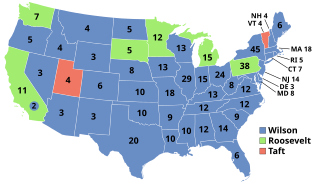
The 1912 United States presidential election was the 32nd quadrennial presidential election, held on Tuesday, November 5. Democratic Governor Woodrow Wilson of New Jersey unseated incumbent Republican President William Howard Taft and defeated former President Theodore Roosevelt, who ran under the banner of the new Progressive or "Bull Moose" Party. As of 2020, this is the most recent presidential election in which a top two finisher was neither a Democrat nor a Republican.

Big stick ideology, big stick diplomacy, or big stick policy refers to President Theodore Roosevelt’s foreign policy: "speak softly and carry a big stick; you will go far." Roosevelt described his style of foreign policy as "the exercise of intelligent forethought and of decisive action sufficiently far in advance of any likely crisis." As practiced by Roosevelt, big stick diplomacy had five components. First it was essential to possess serious military capability that would force the adversary to pay close attention. At the time that meant a world-class navy. Roosevelt never had a large army at his disposal. The other qualities were to act justly toward other nations, never to bluff, to strike only when prepared to strike hard, and the willingness to allow the adversary to save face in defeat.

USS Theodore Roosevelt (CVN-71) is the fourth Nimitz-class nuclear powered aircraft carrier in the United States Navy. She is named in honor of Theodore Roosevelt, the 26th President of the United States and a proponent of naval power. She is the fourth ship named in honor of Theodore Roosevelt, three bearing his full name and a fourth with just his last name. Another three U.S. Navy ships have "Roosevelt" in their names in honor of members of the Roosevelt family. This carrier's radio call sign is "Rough Rider", the nickname of President Roosevelt's volunteer cavalry unit during the Spanish–American War. She was launched in 1984, and saw her first action during Operation Desert Storm in 1991.

Edith Kermit Roosevelt was the second wife of President Theodore Roosevelt and served as the first lady of the United States during his presidency from 1901 to 1909. She also served as the second lady of the United States in 1901. Roosevelt was the first first lady to employ a full-time, salaried social secretary. Her tenure resulted in the creation of an official staff, and her formal dinners and ceremonial processions served to elevate the position of first lady.

Alice Lee Roosevelt Longworth was an American writer and prominent socialite. She was the eldest child of U.S. President Theodore Roosevelt and the only child of Roosevelt and his first wife, Alice Hathaway Lee.

Theodore Roosevelt III, known as Theodore Roosevelt Jr., was an American government, business, and military leader. He was the eldest son of President Theodore Roosevelt and First Lady Edith Roosevelt. Roosevelt is known for his World War II service, including the directing of troops at Utah Beach during the Normandy landings, for which he received the Medal of Honor.
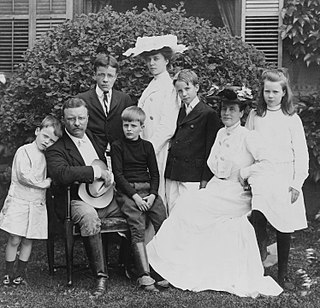
The Roosevelt family is an American political family from New York whose members have included two United States Presidents, a First Lady, and various merchants, politicians, inventors, clergymen, artists, and socialites. The progeny of a mid-17th century Dutch immigrant to New Amsterdam, many members of the family became locally prominent in New York City politics and business and intermarried with prominent colonial families. Two distantly related branches of the family from Oyster Bay and Hyde Park, New York rose to national political prominence with the elections of Presidents Theodore Roosevelt (1901–1909) and his fifth cousin Franklin D. Roosevelt (1933–1945), whose wife, First Lady Eleanor Roosevelt, was Theodore's niece.
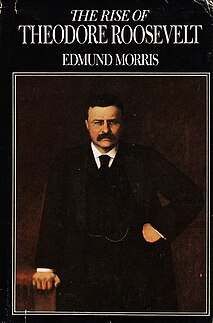
The Rise of Theodore Roosevelt (1979) is a biography of United States President Theodore Roosevelt by Edmund Morris and published by Coward, McCann & Geoghegan when the author was forty years old. It is the first in a trilogy continued more than twenty and thirty years later by Theodore Rex (2001) and Colonel Roosevelt (2010). It won the 1980 Pulitzer Prize for Biography or Autobiography and the 1980 National Book Award in Biography.

Theodore Roosevelt Birthplace National Historic Site is a recreated brownstone at 28 East 20th Street, between Broadway and Park Avenue South, in the Flatiron District of Manhattan, New York City. It is the birthplace and childhood home of 26th President of the United States Theodore Roosevelt.

Theodore Roosevelt Sr. was an American businessman and philanthropist from the Roosevelt family. Roosevelt was also the father of President Theodore Roosevelt and the paternal grandfather of First Lady Eleanor Roosevelt. He served as a member of the plate-glass importing business Roosevelt & Son.
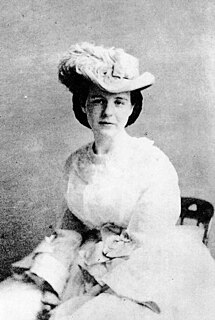
Martha Bulloch "Mittie" Roosevelt was an American socialite. Roosevelt was also the mother of US President Theodore Roosevelt and the paternal grandmother of Eleanor Roosevelt. She was a great-granddaughter of Archibald Bulloch, grandniece of William Bellinger Bulloch, and granddaughter of General Daniel Stewart. A true Southern belle, Roosevelt is thought to have been one of the inspirations for Scarlett O'Hara.

Anna Roosevelt Cowles was an American socialite. She was the older sister of United States President Theodore Roosevelt and an aunt of Eleanor Roosevelt. Her childhood nickname was Bamie, a derivative of bambina, but as an adult, her family began calling her Bye because of her tremendous on-the-go energy. Throughout the life of her brother, Theodore, she remained a constant source of emotional support and practical advice. On the child-bed death of her brother Theodore's young wife Alice Hathaway Lee, Bamie took custody of the child, assuming parental responsibility for T.R.'s first daughter, Alice Lee Roosevelt, during her early years.
Theodore Roosevelt (1858–1919) was the 26th President of the United States.
Nicholas Roosevelt was an American diplomat and journalist. A member of the Roosevelt family and first-cousin once removed of U.S. President Theodore Roosevelt, he was born in New York City to James West Roosevelt, a brother of Hilborne Roosevelt, and Laura Henrietta d'Oremieulx. Brought up in Oyster Bay, New York, he graduated from Harvard University in 1914. He was an attaché at the American Embassy in Paris, secretary to the American mission to Spain in 1916 and 17, vice-governor of the Philippine Islands in 1930, and U.S. minister to Hungary from 1930 to 1933. He was a member of the Council on Foreign Relations and a writer for its journal Foreign Affairs, and a foreign correspondent and editorial writer for the New York Times and New York Herald Tribune from 1921 to 1946. A prolific author, his autobiography, A Front Row Seat (1953), offers a critical view of Franklin D. Roosevelt, a distant cousin, and an inside view of the New York Times. Theodore Roosevelt (1967) drew on Nicholas Roosevelt's unique childhood recollections, his father having been a close friend of Theodore. He was married to Tirzah Gates, the daughter of California State Senator Egbert Gates. Her sister, Dorothy Gates, was the first wife of eminent astrophysicist Fritz Zwicky. He remained lifelong friends with Fritz Zwicky. He lived in Big Sur, California in later life.

William Loeb Jr. was an American political figure. He was the Presidential secretary to President Theodore Roosevelt and Collector of the Port of New York from 1909 to 1913. He was the father of William Loeb III, the conservative publisher of the Manchester Union Leader.
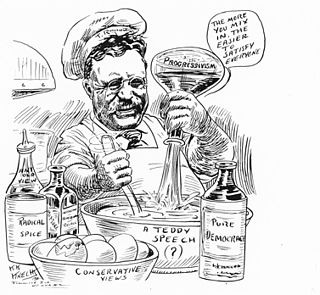
Theodore Roosevelt (1858–1919) was the 26th President of the United States (1901–1909) and also served as Governor of New York and Vice President. He is known for becoming a leading spokesman for his version of progressivism after 1890. However, author Daniel Ruddy argues in his book Theodore the Great: Conservative Crusader that Roosevelt was actually a "populist conservative" and a "Hamiltonian"—a conservative in the eighteenth century sense of the word. Similarly, Francis Fukuyama identifies Roosevelt, together with Alexander Hamilton, as part of a tradition of a strong-state conservatism in the United States. Roosevelt has been the main figure identified with progressive conservatism as a political tradition. Roosevelt stated that he had "always believed that wise progressivism and wise conservatism go hand in hand".

This Theodore Roosevelt bibliography lists the works written by Theodore Roosevelt. Roosevelt was a diligent and skilled writer. When he lost his fortune in the Dakota Territory in 1886 and needed to make a living to support his family, he did so for the rest of his life by writing. Roosevelt wrote on a wide range of topics and genres, including history, autobiography, biography, commentary and editorials, memoirs, nature, and guide books. In addition, by one estimate Roosevelt wrote more than 150,000 letters. In his writing, Roosevelt in his style could be strong, introspective, exuberant, or angry—the subject dictated the style.
This bibliography of Theodore Roosevelt is a list of published works about Theodore Roosevelt, 26th President of the United States. The titles are selected from tens of thousands of publications about him.
References
- ↑ "Theodore Roosevelt; an autobiography ..." Library of Congress . Retrieved June 1, 2019.
| This article about a biographical or autobiographical book on an American politician is a stub. You can help Wikipedia by expanding it. |